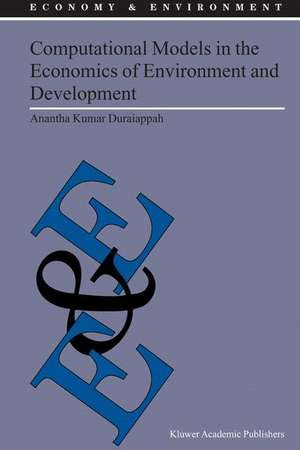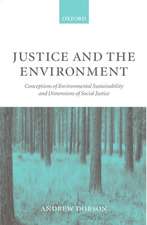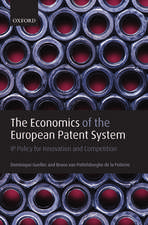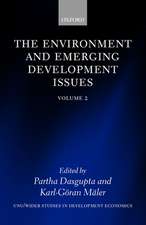Computational Models in the Economics of Environment and Development: Economy & Environment, cartea 27
Autor A.K. Duraiappahen Limba Engleză Hardback – 31 dec 2003
This book is targeted towards university lecturers and students in economic modeling and sustainable development, but is also of particular interest to researchers at sustainable development research institutes and policy makers at international sustainable development policy institutions such the World Bank, UNDP, and UNEP.
| Toate formatele și edițiile | Preț | Express |
|---|---|---|
| Paperback (1) | 389.31 lei 6-8 săpt. | |
| SPRINGER NETHERLANDS – 31 dec 2003 | 389.31 lei 6-8 săpt. | |
| Hardback (1) | 394.71 lei 6-8 săpt. | |
| SPRINGER NETHERLANDS – 31 dec 2003 | 394.71 lei 6-8 săpt. |
Din seria Economy & Environment
- 18%
 Preț: 1226.11 lei
Preț: 1226.11 lei - 18%
 Preț: 1230.35 lei
Preț: 1230.35 lei - 18%
 Preț: 959.98 lei
Preț: 959.98 lei - 15%
 Preț: 643.65 lei
Preț: 643.65 lei - 18%
 Preț: 952.40 lei
Preț: 952.40 lei - 18%
 Preț: 951.77 lei
Preț: 951.77 lei - 18%
 Preț: 952.72 lei
Preț: 952.72 lei - 15%
 Preț: 643.48 lei
Preț: 643.48 lei - 15%
 Preț: 645.28 lei
Preț: 645.28 lei - 15%
 Preț: 644.82 lei
Preț: 644.82 lei - 15%
 Preț: 639.41 lei
Preț: 639.41 lei - 15%
 Preț: 643.48 lei
Preț: 643.48 lei - 18%
 Preț: 953.52 lei
Preț: 953.52 lei - 15%
 Preț: 646.62 lei
Preț: 646.62 lei - 15%
 Preț: 640.37 lei
Preț: 640.37 lei - 15%
 Preț: 644.30 lei
Preț: 644.30 lei - 15%
 Preț: 646.62 lei
Preț: 646.62 lei - 15%
 Preț: 645.96 lei
Preț: 645.96 lei - 18%
 Preț: 957.32 lei
Preț: 957.32 lei - 15%
 Preț: 647.40 lei
Preț: 647.40 lei - 18%
 Preț: 947.67 lei
Preț: 947.67 lei - 15%
 Preț: 637.78 lei
Preț: 637.78 lei - 15%
 Preț: 638.11 lei
Preț: 638.11 lei - 18%
 Preț: 953.03 lei
Preț: 953.03 lei - 18%
 Preț: 846.79 lei
Preț: 846.79 lei
Preț: 394.71 lei
Nou
Puncte Express: 592
Preț estimativ în valută:
75.53€ • 80.77$ • 62.97£
75.53€ • 80.77$ • 62.97£
Carte tipărită la comandă
Livrare economică 18 aprilie-02 mai
Preluare comenzi: 021 569.72.76
Specificații
ISBN-13: 9781402017735
ISBN-10: 1402017731
Pagini: 252
Ilustrații: XVIII, 230 p.
Dimensiuni: 155 x 235 x 19 mm
Greutate: 0.57 kg
Ediția:2003
Editura: SPRINGER NETHERLANDS
Colecția Springer
Seria Economy & Environment
Locul publicării:Dordrecht, Netherlands
ISBN-10: 1402017731
Pagini: 252
Ilustrații: XVIII, 230 p.
Dimensiuni: 155 x 235 x 19 mm
Greutate: 0.57 kg
Ediția:2003
Editura: SPRINGER NETHERLANDS
Colecția Springer
Seria Economy & Environment
Locul publicării:Dordrecht, Netherlands
Public țintă
ResearchCuprins
1: A Generalized Integrated Economic-Environmental Growth Model.- 2: Formulating and Solving Non-Linear Integrated Ecological-Economic Models Using GAMS.- 3: Investing in Clean Technology: An Exercise in Methodology.- 4: Issues in Production, Recycling and International Trade: Analyzing the Plastic Sector Using an Optimal Life Cycle (OLC) Model.- 5: The Economic and Environmental Impact of Waste Paper Trade and Recycling in India: A Life Cycle Approach with an Endogenous Input-Output Technology Matrix.- 6: Farm Permits and Optimal Shrimp Management in Thailand: An Integrated Inter-Temporal and Spatial Planning Model.- 7: Sustainable Livestock Management in the Kalahari.
Caracteristici
Invaluable not only because of its practical and comprehensive guidance on developing applied environment-development models for policy, but particularly because of its use of applied, real-life examples, causing it to be a solid basis for developing models anchored firmly in praxis


















